“Do The Right Thing” – PMI® Requirements Management Webinar Recap
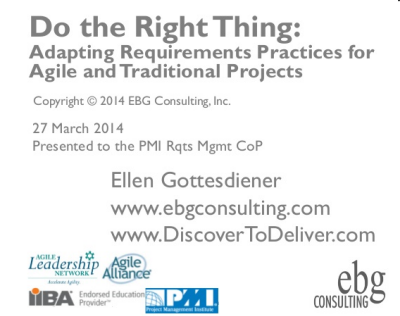 Last month I presented a webinar to the PMI® (Project Management Institute) Requirements Management Community of Practice: “Do the Right Thing: Adapting Requirements Practices for Agile and Traditional Projects.”
Last month I presented a webinar to the PMI® (Project Management Institute) Requirements Management Community of Practice: “Do the Right Thing: Adapting Requirements Practices for Agile and Traditional Projects.”
The Requirements Management CoP has grown exponentially and will continue to do so, especially since the PMI recently announced the new Professional in Business Analysis certification (PMI-PBA). This growth was reflected in the full webinar room during the live event. During the webinar, I shared requirements discovery and delivery principles and practices along a gradient from traditional to agile.
As you review the deck, there are some key points to know:
Continue reading
 Whether you are agile or more traditional, your challenge is the same: In order to remain relevant in today’s market, you have to discover and deliver the right thing at the right time. To do this successfully, you need to elicit customer needs and quickly choose from among many competing voices and options to determine what is truly essential and what can wait for a future release. That means selecting the requirements development and management activities that are most effective for your particular situation–whether those practices are in your current toolbox or not.
Whether you are agile or more traditional, your challenge is the same: In order to remain relevant in today’s market, you have to discover and deliver the right thing at the right time. To do this successfully, you need to elicit customer needs and quickly choose from among many competing voices and options to determine what is truly essential and what can wait for a future release. That means selecting the requirements development and management activities that are most effective for your particular situation–whether those practices are in your current toolbox or not.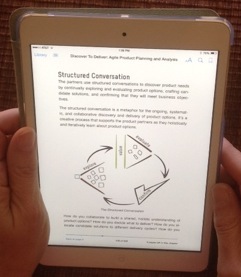 “Fast, easy, free/cheap…” That’s what we heard about publishing an eBook edition of a paper book. After all, people said, how difficult can it be to take a PDF and make it digital? Quite difficult, actually.
“Fast, easy, free/cheap…” That’s what we heard about publishing an eBook edition of a paper book. After all, people said, how difficult can it be to take a PDF and make it digital? Quite difficult, actually.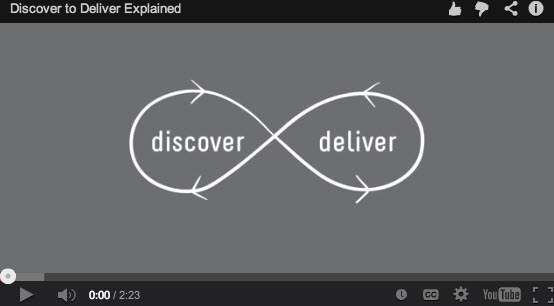 We’re excited to announce the release of “Discover to Deliver Explained.” This two-minute video provides an animated overview of the key concepts in our book
We’re excited to announce the release of “Discover to Deliver Explained.” This two-minute video provides an animated overview of the key concepts in our book 

 As I prepare to deliver my tutorial (“The Essential Product Owner”) and presentation (“Product Roadmaps: Collaborating to Deliver Value”) at Product Management Festival in Zurich later this month, I wanted to share with you an excerpt of an interview with Mary Gorman and me that was recently published on their blog.
As I prepare to deliver my tutorial (“The Essential Product Owner”) and presentation (“Product Roadmaps: Collaborating to Deliver Value”) at Product Management Festival in Zurich later this month, I wanted to share with you an excerpt of an interview with Mary Gorman and me that was recently published on their blog.
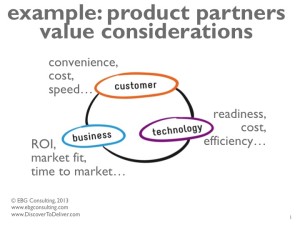 Last time, I told the story of a team that experienced a breakthrough after clarifying the scope of a stalled project. Noting that scope creep—the unrestrained expansion of requirements as the project proceeds—is cited as one of the top project risks, I promised to describe some of the good practices that help product partners manage product scope in a disciplined way. With clients, I always stress the importance of developing a product vision, identifying goals and objectives for the product, and clarifying the product partners’ value considerations very early in the project before development proceeds. Let’s look at ways to do that.
Last time, I told the story of a team that experienced a breakthrough after clarifying the scope of a stalled project. Noting that scope creep—the unrestrained expansion of requirements as the project proceeds—is cited as one of the top project risks, I promised to describe some of the good practices that help product partners manage product scope in a disciplined way. With clients, I always stress the importance of developing a product vision, identifying goals and objectives for the product, and clarifying the product partners’ value considerations very early in the project before development proceeds. Let’s look at ways to do that.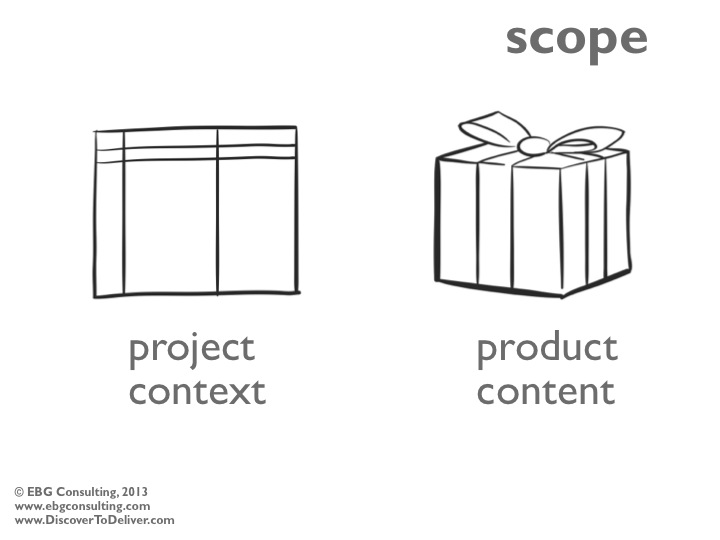 Recently I worked with a project team developing a software product under grant from four entities, with a government agency as their ultimate customer. They called me in because, three months into a four-month project, they were desperately behind. Why? They’d been spinning in circles, trying to satisfy diverse stakeholders who had overlapping as well as conflicting requirements. The funding was split among several competitors, each with its own competencies, and there was a sense that the government agency was playing favorites based on its own preferences in the domain.
Recently I worked with a project team developing a software product under grant from four entities, with a government agency as their ultimate customer. They called me in because, three months into a four-month project, they were desperately behind. Why? They’d been spinning in circles, trying to satisfy diverse stakeholders who had overlapping as well as conflicting requirements. The funding was split among several competitors, each with its own competencies, and there was a sense that the government agency was playing favorites based on its own preferences in the domain.